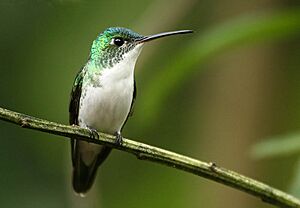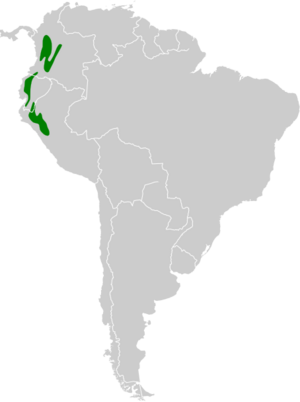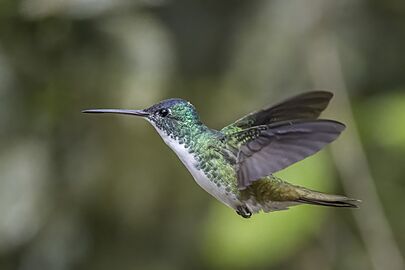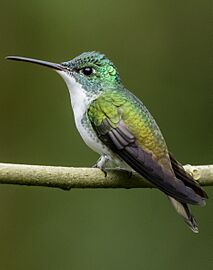Andean emerald facts for kids
Quick facts for kids Andean emerald |
|
|---|---|
 |
|
| Uranomitra franciae viridiceps, Ecuador | |
| Conservation status | |
| Scientific classification | |
| Genus: |
Uranomitra
|
| Species: |
franciae
|
 |
|
| Synonyms | |
|
Amazilia franciae |
|
The Andean emerald (Uranomitra franciae) is a beautiful hummingbird found in Colombia, Ecuador, and Peru. It belongs to a group of hummingbirds known as "emeralds."
Contents
About the Andean Emerald
How Scientists Group Them
Scientists group living things into categories. The Andean emerald used to be in a group called Amazilia. But after new studies, most scientists now place it in a different group called Uranomitra. This new group was first named in 1854. However, some groups, like BirdLife International, still call it Amazilia.
The Andean emerald is the only species in its current group, Uranomitra. There are three types, or subspecies, of Andean emerald:
- U. f. franciae
- U. f. viridiceps
- U. f. cyanocollis
-
male U. f. viridiceps, Bellavista Cloud Forest Reserve, Ecuador
What They Look Like
The Andean emerald is about 9 to 11 centimeters (3.5 to 4.3 inches) long. Males weigh around 5.6 grams (0.2 ounces), and females are a bit lighter at 5.3 grams (0.19 ounces).
Both male and female Andean emeralds have a medium-length beak. It can be straight or slightly curved downwards. The upper part of their beak is blackish. The lower part is coral red with a dark tip.
Male and Female Differences
Adult males of the U. f. franciae type have a shiny violet-blue top of the head. Their cheeks and neck are a sparkling golden-green or emerald green. Their back and sides are light green to golden-green. The feathers covering their upper tail have a coppery color. The middle of their belly is white. Their tail is bronze-green or coppery.
Adult females look similar to males. However, the top of their head is turquoise-blue or greenish, and it's not as shiny. Young birds look like adult females. They also have brownish edges on the feathers of their back and grayish-brown sides.
Differences in Subspecies
The U. f. viridiceps subspecies has a shorter tail and a green top of the head. The U. f. cyanocollis subspecies is also slightly different. The blue color on the top of its head extends further back to its neck.
Where They Live
The different types of Andean emeralds live in specific areas:
- U. f. franciae lives in the Andes mountains of northwestern and central Colombia.
- U. f. viridiceps is found in the Andes from southwestern Colombia. It also lives through western Ecuador to the Loja Province.
- U. f. cyanocollis lives in the Andes of southeastern Ecuador. It is also found in northern Peru's Marañón River valley. This range extends south and east to La Libertad Province.
Andean emeralds live in secondary forests. They also like the edges and clearings of wet primary forests. In Peru, they can also be found in drier shrublands. They live at elevations between 600 and 2,100 meters (2,000 to 6,900 feet). They are most common above 1,000 meters (3,300 feet).
Andean Emerald Behavior
How They Move Around
Andean emeralds sometimes move to different elevations depending on the season. However, scientists don't fully understand these movements yet.
What They Eat
The Andean emerald drinks nectar from many different flowering plants. These include herbs, vines, and trees. They usually feed in the middle or upper parts of the forest. They often visit a circuit of nectar sources, like following a path. Sometimes they feed with other hummingbirds. However, they are not as dominant as some other birds. Besides nectar, they also eat insects. They catch insects by flying out from a perch, like a branch, and grabbing them in the air.
How They Raise Their Young
Andean emeralds have been seen breeding almost all year round. They build a cup-shaped nest. They use treefern scales and plant fibers. They hold it all together with spiderwebs. They also put lichen on the outside of the nest. They usually build their nests about 1.4 to 2.3 meters (4.6 to 7.5 feet) above the ground.
The female bird sits on two eggs for 19 to 24 days. The young birds leave the nest about 16 to 22 days after they hatch.
Their Calls and Songs
The Andean emerald has a very varied song. People describe it as a repeated, complex sound. It includes high-pitched squeaky whistles, trills, and scratchy notes. They also make a high-pitched "tsip" call. When they interact with other birds, they make "scratchy squeaky chatters."
Conservation Status
The IUCN (International Union for Conservation of Nature) has evaluated the Andean Emerald. They have assessed it as a species of "Least Concern." This means it is not currently considered to be at high risk of extinction. Scientists don't know the exact number of these birds or if their population is growing or shrinking. No immediate threats to the species have been found. It is considered uncommon to fairly common. It can also be found in at least one protected area.





